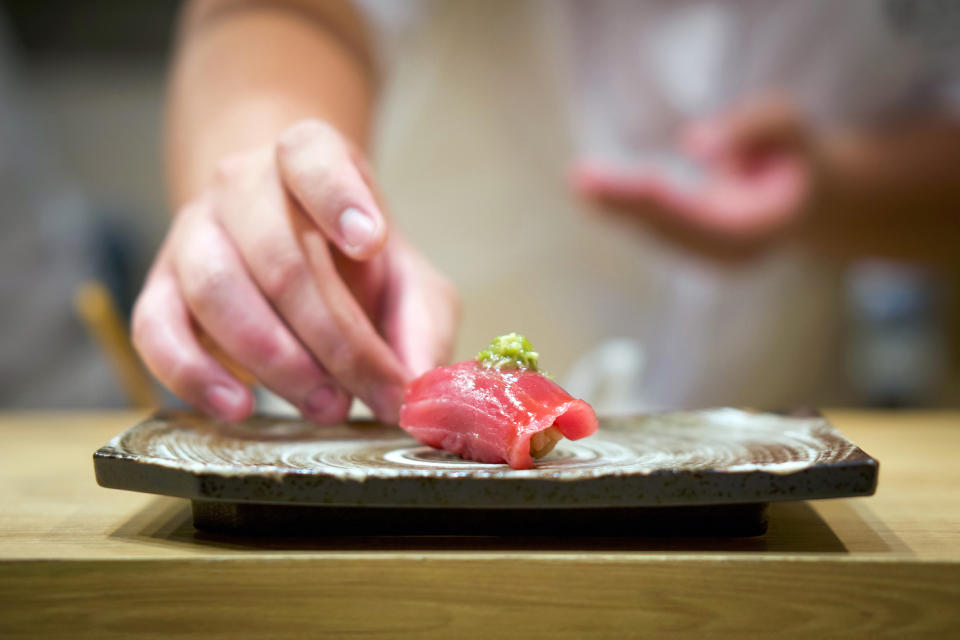Banh mi and omakase join the dictionary. What it says about Asian cultural influence.
- Oops!Something went wrong.Please try again later.
When Andrea Nguyen was growing up in the 1970s and 80s, banh mi was still an insular Asian experience. Found almost solely in enclaves of Vietnamese refugees, it was a low-cost community staple — a practical, portable dish just as much as a tasty one.
But banh mi is now so ubiquitous that last week it was added to Merriam-Webster’s Dictionary alongside 370 other words. “Omakase,” the Japanese concept of chef’s choice dining, and “maitake,” a mushroom consumed widely in Asia, were also added.
Webster’s Dictionary is known for cementing trendy vocabulary to its ranks each year. Banh mi and omakase are being ushered in alongside words like “plant-based,” “cringe,” and “sus.”

“Dictionaries reflect how mainstream and how popular foods are,” said Nguyen, now a recipe developer and author of “The Banh Mi Handbook.” “Trying to push Asian food from the margins is really my overarching goal. It signals this acceptance. Like, ‘No, you’re no longer foreign.’”
Nguyen said she saw banh mi’s popularity grow over the decades. As more Vietnamese Americans moved out of ethnic neighborhoods, so did the banh mi. By the 2010s, it was a household name for the customizable sandwich of pate, pickled veggies and meat on a baguette, sold almost everywhere in the U.S
With Asian food rocketing in popularity, food experts say adding culturally specific words to dictionaries is the only reasonable way to go.
“The future of American food has a strong Asianization,” said Krishnendu Ray, an associate professor of Food Studies at New York University.
When the English language fails to adequately describe something with existing words, that’s when new, cultural vocabulary tends to get added, he said.
“These terms have met our criteria for entry as words an English speaker is likely to encounter,” Peter Sokolowski, an editor at large for Merriam-Webster, told NBC News. “They have shown both widespread and long-term use, and can now be considered to be English words.”
Though she’s excited by the concept of bringing bahn mi to a larger audience, Nguyen takes one issue with the definition Merriam-Webster provides. In its description, the dictionary refers to the banh mi as a “usually spicy sandwich.”
“It doesn’t have to be spicy,” she said. “You can have no chili, just salt and pepper on that sandwich. By saying ‘spicy,’ I feel like it further exoticizes the sandwich.”
Ethnic dishes and the terms to describe them are constantly impacting the way Americans talk about food, Ray said. He pointed to cuisines like Italian and French, introduced to the North American palate a century ago, which are now inextricably linked to the way we talk about food.
“Why do we use ‘pasta’ as a word?” he said. “We use it because it’s a specific form of food, which in some ways was unknown, unfamiliar and had to be incorporated into the English language … For banh mi, you can technically call it a sandwich, but it’s not specific enough.”
There are two main ways food words are introduced into society, according to Ray: from the top down or from the bottom up.
French food words, Ray said, were introduced as markers of luxury and fine dining, and eventually trickled into casual American lingo. Japanese omakase, usually a higher-end experience, is being incorporated in the same way.

In cities like New York, Ray sees Japanese food replacing French food as the most elite.
“Omakase is analogous to the word ‘restaurant’ or the word ‘entree,’” he said. “Standard omakase menus in New York City are the most expensive restaurants in New York City, around $200.”
On the other side, banh mis are a bottom or middle-up food, first gaining a foothold in lower middle class immigrant communities and working its way into the mainstream. Nguyen remembers her family going out food shopping when she was a kid and coming home with large grocery bags filled with banh mis.
“We came to the United States, and people were longing for the foods of their homeland,” she said. “And banh mi, you can make it from supermarket bread and it tastes superb … The nature of a lot of Vietnamese food is it’s very practical.”
Often exoticized and painted with a broad brush as spicy or pungent, Asian food’s inclusion in Webster is a step toward normalization, Nguyen said. Samosa, bibimbap, soju and kimchi have been added in previous years.
“Part of me says, ‘What took you so long?’” she said. ‘But then the other part of me says, ‘Hey, this is great, because there are still a lot of people who need to know what this food is.’”
This article was originally published on NBCNews.com

